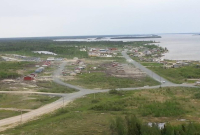Support strong Canadian climate journalism for 2025
Solutions to the housing crisis in Indigenous communities should be viewed holistically and include cultural, health and energy-efficiency outcomes, a new report says.
The report, written in collaboration with the Canadian Climate Institute and Indigenous Clean Energy, brings forward the concept of “healthy energy homes,” which are efficient, climate adaptive and support well being. The idea is not intended to create a new standard like net-zero or passive housing that can be certified, but instead is specific to each nation.
The report suggests Indigenous housing must be different from the past by “creating that space for culture and creating that space for doing things in a way that makes sense for the community,” Janna Wale, a report co-author, told Canada’s National Observer.
Take, for example, the Nuxalk Nation’s new house design in Bella Coola, British Columbia, Ian Scholten, another report co-author said. The house, which serves as a case study in the report, is designed with a separate kitchen to prepare wild game and salmon to help control moisture.
The report’s new Indigenous-led housing concept stands in a stark contrast to how colonialism and systemic discrimination helped cause the housing crisis. Generations of colonial policies destroyed traditional housing forms, such as wigwams, igloos and big houses that marked a diversity of Indigenous architecture pre-contact, the report says.
Now, housing on First Nations is often second rate compared to the rest of Canada. The average lifespan for on-reserve homes is about 15 years, compared to 35 years for off-reserve housing, according to a paper published last month. Other estimates, like a report published by the First Nations National Building Officers Association a decade ago, found the average lifespan of reserve housing was only eight to 10 years.
“As a result, rather than growing the stock of available housing to reduce overcrowding, communities are simply replacing existing homes,” the report explains.

Housing also often remains inadequate given cultural values of some communities. For example, eight or nine people in a house may not be overcrowding for a nation that values intergenerational living, but it is for the design of a home in many Indigenous communities.
The housing crisis in Indigenous nations “needs to be addressed holistically, right?” Scholten says. It “can't just be dumping money at it to just build the same kind of home. We need to think differently and how this works at the community level.”
The Assembly of First Nations reported last year that about $135 billion will be needed to house people in First Nations to the standards of non-First Nations communities. Meanwhile, Ottawa has allocated $6.3 billion over seven years.
A final report with policy recommendations is scheduled for next year, the co-authors say.
Matteo Cimellaro / Canada’s National Observer / Local Journalism Initiative







Comments